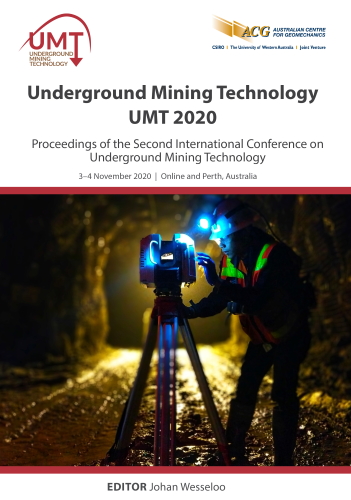Rock forecast tool: new tool for rock mass quality prediction in tunnelling

|
Authors: Tapia, A; Farías, A |
DOI https://doi.org/10.36487/ACG_repo/2035_02
Cite As:
Tapia, A & Farías, A 2020, 'Rock forecast tool: new tool for rock mass quality prediction in tunnelling', in J Wesseloo (ed.), UMT 2020: Proceedings of the Second International Conference on Underground Mining Technology, Australian Centre for Geomechanics, Perth, pp. 117-136, https://doi.org/10.36487/ACG_repo/2035_02
Abstract:
The tool presented in this article, known as rock forecast tool (RFT), is based on the quantitative interpretation of the geological characteristics obtained from the drilling of exploratory drill holes towards the unexcavated zone of tunnels under construction. This correlates the drilling results with rock quality values that have been previously calculated on the advanced faces. The results provided by this new tool are numerical values of rock mass quality in each of the drill rods used in exploratory drilling. The results obtained by the RFT have been subjected to different statistical tests such as the Pearson's correlation coefficient, R hypothesis test, confidence intervals and covariance test. All the tests carried out show that the RFT, used as a predictor, has a high correlation with the rock mass quality values that are subsequently calculated in the excavated sections, with an R2 = 0.95.
Keywords: tunnelling, rock mass quality, prediction, exploratory drilling
References:
Achen, H 1982, Interpreting and Using Regression, Sage, London.
Bieniawski, ZT 1989, Engineering Rock Mass Classifications - A Complete Manual for Engineers and Geologists in Mining, Civil and Petroleum Engineering, Wiley, New York.
Cohen, J & Cohen, P 1983, Applied Multiple Regression/Correlation Analysis for the Behavioural Sciences, Lawrence Erlbaum Associates, Inc., Hillsdale.
Chungin, L & Shucai, L 2014, Tunnel Seismic Prediction (TSP) and its application in tunnel engineering, Applied Mechanics and Materials, vol. 501–504, pp. 1779–1782.
Galende, M, Fuente, M, Sainz-Palmero, G & Menéndez, M 2018, Monitor-while-drilling - based estimation of rock mass rating with computational intelligence: the case of tunnel excavation front, Automation in Construction, vol. 93, pp. 325–338,
Hoek, E & Brown, ET 1980a, Underground Excavations in Rock, Institution of Mining and Metallurgy, London.
Hoek, E & Brown, ET 1980b, Empirical strength criterion for rock masses. Journal of the Geotechnical Engineering Division, 106(GT9), pp. 1013–1035.
Hoek, E & Brown, ET 2018, The Hoek–Brown Failure Criterion and GSI - 2018 Edition, Journal of Rock Mechanics and Geotechnical Engineering, vol. 11, issue 3, pp. 445–463.
Norwegian Geotechnical Institute 2015, Using the Q System, Rock Mass Classification and Support Design, Norwegian Geotechnical Institute, Oslo.
Oraee, K, Mozafari, A, Goodarzi, A & Oraee-Mirzamani, N 2014, Final wall stability in metal open pit mines using presplit blasting, online presentation, viewed 10 December 2019,
Palmström, A 2009, Combining the RMR, Q, and RMi Classification Systems, Tunnelling and Underground Space Technology, vol. 24, issue 4, pp. 491–492.
Pedhazur, J 1997, Multiple Regression in Behavioural Research, 3rd edn. Harcourt Brace, Orlando.
Tunnel El Melón II 2018, Internal Reports of Tunnel El Melón II Construction, unpublished.
© Copyright 2025, Australian Centre for Geomechanics (ACG), The University of Western Australia. All rights reserved.
View copyright/legal information
Please direct any queries or error reports to repository-acg@uwa.edu.au
View copyright/legal information
Please direct any queries or error reports to repository-acg@uwa.edu.au
